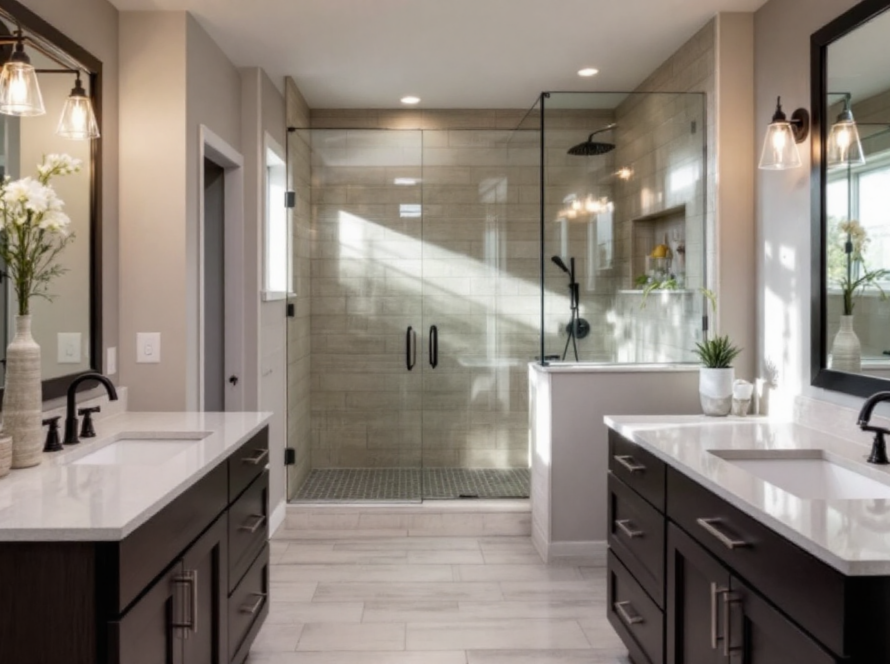The bathroom vanity is more than just a sink—it’s a focal point that sets the tone for your space. Whether you have a compact powder room or a spacious master bath, choosing the right vanity for your bathroom is crucial for both function and aesthetics.
Too small, and you’ll lack storage. Too big, and your bathroom will feel cramped. And then there’s style—do you go modern, traditional, or something in between? In this guide, we’ll help you navigate vanity sizes, styles, materials, and installation tips to ensure you make the perfect choice.
TL;DR – Quick Guide
- Measure your space carefully to determine the ideal vanity size.
- Consider storage needs—drawers, cabinets, and open shelving all have different benefits.
- Pick a style that complements your bathroom—modern, traditional, or transitional.
- Choose durable materials like solid wood or moisture-resistant MDF.
- Decide between freestanding and wall-mounted vanities based on space and aesthetic preference.
Detailed Breakdown
1. Vanity Size: How to Choose the Right Fit
Before picking a vanity, you need to consider your bathroom layout. Here’s a breakdown of ideal vanity sizes for different spaces:
Small Bathrooms & Powder Rooms (24″–30″)
- Compact, space-saving designs
- Best for single-sink vanities
- Ideal for guest bathrooms or tight spaces
Standard Full Bathrooms (36″–48″)
- Offers a balance between storage and space
- Typically accommodates one sink with ample counter space
- Suitable for small families or shared bathrooms
Master Bathrooms (60″–72″)
- Perfect for double sinks and extra storage
- Ideal for couples or family homes
- Adds a luxurious feel to larger bathrooms
✅ Pro Tip: Always leave at least 30 inches of clearance space in front of the vanity for comfortable use.
2. Vanity Styles: Which One Matches Your Bathroom?
Your vanity should complement the overall aesthetic of your bathroom. Here are the three most popular styles:
Modern Vanities
- Sleek, minimalist designs
- Floating (wall-mounted) options for a clean look
- High-gloss or matte finishes with simple hardware
Traditional Vanities
- Rich wood tones with intricate detailing
- Often freestanding with ornate legs or molding
- Works best in classic or vintage-inspired bathrooms
Transitional Vanities
- A mix of modern and traditional elements
- Neutral colors with clean yet classic lines
- Versatile enough for most bathroom designs
✅ Pro Tip: If you’re unsure, go for a transitional vanity—it blends well with various styles and is a safe long-term choice.
3. Storage Solutions: Drawers, Cabinets, or Open Shelving?
Storage is just as important as style when choosing the right vanity for your bathroom. Consider these options:
- Cabinets: Best for hiding toiletries, towels, and cleaning supplies.
- Drawers: Great for organizing smaller items like makeup, razors, and brushes.
- Open Shelving: Perfect for decorative storage (e.g., baskets, rolled towels).
✅ Pro Tip: If multiple people use the bathroom, opt for a mix of drawers and cabinets for easy organization.
4. Vanity Materials: What’s Durable and Moisture-Resistant?
Since bathrooms are humid environments, your vanity material must withstand moisture. Here are the best options:
- Solid Wood: Durable and long-lasting, but requires proper sealing.
- Plywood: A budget-friendly alternative with good water resistance.
- MDF (Medium-Density Fiberboard): Affordable and smooth but prone to water damage if not sealed properly.
- Metal or Glass: Modern and stylish, but requires frequent cleaning to avoid fingerprints and water spots.
✅ Pro Tip: If choosing MDF, go for water-resistant finishes to prevent warping over time.
5. Freestanding vs. Wall-Mounted Vanities: Which Is Better?
Freestanding Vanities
✔ Traditional look, works in most bathrooms
✔ Offers ample storage space
✔ Easier to install and replace
❌ Takes up more floor space
Wall-Mounted (Floating) Vanities
✔ Creates an open, airy feel
✔ Ideal for modern or small bathrooms
✔ Easier to clean underneath
❌ Less storage space compared to freestanding vanities
✅ Pro Tip: If you have a small bathroom, a wall-mounted vanity can make the space feel bigger.
Key Takeaways
- Size matters! Choose a vanity that fits your bathroom dimensions and provides enough clearance.
- Style it right. Pick a modern, traditional, or transitional vanity that complements your décor.
- Storage is key. Consider drawers, cabinets, or open shelving based on your needs.
- Material durability matters. Opt for solid wood, plywood, or water-resistant MDF for long-lasting use.
- Choose your type. Freestanding vanities offer more storage, while floating vanities maximize space.
By following these tips, you’ll be well on your way to choosing the right vanity for your bathroom that balances function, style, and durability.
FAQs
1. What size vanity is best for a small bathroom?
For small bathrooms or powder rooms, a 24-inch to 30-inch vanity is ideal. It provides just enough space for essentials without making the room feel cramped.
2. Should I get a single or double-sink vanity?
If you have the space, a double-sink vanity (60″+) is great for shared bathrooms. For smaller spaces, a single-sink vanity (36″–48″) is more practical.
3. Are floating vanities a good idea?
Yes! Floating vanities create a modern, space-saving look and make cleaning the bathroom easier. However, they may offer less storage than freestanding options.
4. What is the most durable vanity material?
Solid wood and plywood are the most durable choices, while MDF with a water-resistant coating is a budget-friendly alternative that still holds up well.
5. How do I choose a vanity color?
Neutral tones like white, gray, or natural wood are timeless and work with various bathroom styles. If you want a trendy look, consider deep blues or greens.


